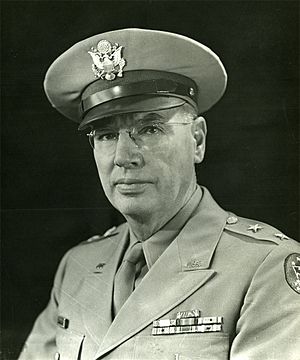George F. Moore (United States Army officer) facts for kids
Quick facts for kids
George Fleming Moore
|
|
|---|---|

Major General George Fleming Moore
|
|
| Born | July 31, 1887 Austin, Texas |
| Died | December 2, 1949 (aged 62) Hillsborough, California |
| Buried |
Golden Gate National Cemetery, San Bruno, California
|
| Allegiance | |
| Service/ |
|
| Years of service | 1909–1949 |
| Rank | |
| Commands held | Harbor Defenses of Manila and Subic Bays |
| Battles/wars | World War I World War II |
| Awards | Distinguished Service Cross Distinguished Service Medal (2) |
George Fleming Moore (born July 31, 1887 – died December 2, 1949) was a brave officer in the United States Army. He became a major general, which is a very high rank. General Moore was in charge of defending important harbors in the Philippines during World War II. He also led the Philippine Coast Artillery during the tough Battle of Bataan.
Contents
Early Life and Education
George Fleming Moore was born in Austin, Texas, on July 31, 1887. His parents were John Marks Moore, Jr. and Mary Estelle Grace Moore. He went to A&M College of Texas and finished in 1908. In 1909, he joined the Coast Artillery Corps as an officer.
Service at Texas A&M
George Moore served in World War I as a major and later a lieutenant colonel. After the war, he returned to Texas A&M University from 1937 to 1940. There, he was the Commandant of Cadets, which meant he was in charge of the student soldiers. During this time, he was promoted to colonel.
World War II Service
During World War II, George Moore was a Brigadier General. He fought in the important Bataan Campaign in the Philippines. He became the commander of the Harbor Defenses of Manila and Subic Bays. This was during the Japanese invasion of the Philippines in 1941–1942.
General Moore was given command of the Philippine Coast Artillery. He had about 5,000 men and four forts to protect Corregidor Island. On May 6, 1942, General Jonathan Wainwright surrendered the Corregidor forces. This led to General Moore and his men being captured by the Japanese.
Prisoner of War
General Moore became a POW and was held by the Japanese. He was finally set free in August 1945, when the war ended. Even while he was a prisoner, General Moore was recognized for his bravery. He received the Distinguished Service Cross and the Distinguished Service Medal.
Family Life
George Moore was married to Lucile Griffith. She was born on March 10, 1892, and passed away on April 5, 1972. They had one daughter named Anne, who later became Mrs. Burton R. Browne.
Later Life and Burial
George Fleming Moore passed away on December 2, 1949. He and his wife, Lucile, are buried together at the Golden Gate National Cemetery in San Bruno, California.
Awards and Honors
General Moore received some of the highest awards from the U.S. Army. These included the Distinguished Service Cross and the Distinguished Service Medal. He received the Distinguished Service Medal twice, shown by an Oak Leaf Cluster.
A building at Texas A&M University is named in his honor. It is called Moore Hall, a residence hall where students live.
Ribbon Bar
| 1st Row | Distinguished Service Cross | |||||||||||
|---|---|---|---|---|---|---|---|---|---|---|---|---|
| 2nd Row | Army Distinguished Service Medal w/ Oak Leaf Cluster |
World War I Victory Medal | American Defense Service Medal with "Foreign Service" clasp |
|||||||||
| 3rd Row | Asiatic-Pacific Campaign Medal w/ two campaign tars |
World War II Victory Medal | Philippine Defense Medal w/ bronze star |
|||||||||
See also
- Jonathan M. Wainwright
- Edward P. King
- Samuel L. Howard
- George M. Parker

